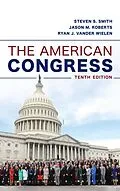The tenth edition of this respected textbook provides a fresh perspective and a crisp introduction to congressional politics. Informed by the authors' Capitol Hill experience and scholarship, the new edition reflects changes in Congress resulting from the 2018 elections and such developments as (a) a new majority party in the House; (b) new campaign spending numbers and election outcomes, rules, committees, leaders, and budget developments; and (c) recent political science literature that provides new perspectives on the institution. The text emphasizes the recent developments and includes important learning aids, including lists of key term, discussion questions and suggested further reading. Alongside clear explanations of congressional rules and the lawmaking process there are examples from contemporary events and debates that highlight Congress as a group of politicians as well as a lawmaking body.
Autorentext
Steven S. Smith , Washington University, St Louis
Steven S. Smith is a Professor of Political Science, the Kate M. Gregg Distinguished Professor of Social Science, and Director of the Murray Weidenbaum Center on the Economy, Government, and Public Policy at Washington University, St Louis. He has chaired the Legislative Studies Section of the American Political Science Association and has served on the editorial boards of the American Journal of Political Science, The Journal of Politics, and Legislative Studies Quarterly.
Jason M. Roberts , University of North Carolina, Chapel Hill
Jason M. Roberts is an Associate Professor of Political Science at the University of North Carolina, Chapel Hill. He co-edited the book Why Not Parties? Party Effects in the US Senate (2009). His articles have been published in the American Political Science Review, the American Journal of Political Science, and Legislative Studies Quarterly.
Ryan J. Vander Wielen , Temple University, Philadelphia
Ryan J. Vander Wielen is an associate professor of Political Science at Temple University, Philadelphia. His articles have been published in the American Political Science Review, the American Journal of Political Science, and Legislative Studies Quarterly, Political Analysis, Legislative Studies Quarter, Public Choice, and Political Research Quarterly.
Inhalt
Preface
Acknowledgments
1. The Troubled Congress
Studying Congress
A Partisan, Centralized Congress
Will Polarized Parties, Centralized Decision Making, and Procedural Warfare Last Forever?
An Unpopular Congress
Other Trends in Congressional Politics
The Changing Congress
Key Terms
Suggested Reading
Discussion Questions
2. Representation and Lawmaking in Congress
Models of Representation
Models of Lawmaking
Rules for Representation and Lawmaking in the Constitution
Beyond the Constitution: The Development of Parties and Committees
Conclusion
Key Terms
Suggested Reading
Discussion Questions
3. Congressional Elections
The Rules Governing Congressional Elections
The Constitution: Eligibility, Voting Rights, and Chamber Size
Federal Law: Apportionment and Campaign Finance
State Law: Redistricting and Primaries
Election Practice Reform
Variations in the Incumbency Advantage
Biased Campaign Funding
Nationalization of Congressional Elections
Midterm Elections
Conclusion
Key Terms
Suggested Reading
Discussion Questions
4. Members, Goals, Resources, and Strategies
Members' Goals
Members' Resources
Influences on Members
Choosing Strategies
Legislative Styles
Conclusion
Key Terms
Suggested Reading
Discussion Questions
5. Parties and Leaders
The Nature of Congressional Parties.
Factions Within Congressional Parties
Party Organizations
Party Leaders
House Party Leaders
Senate Party Leaders
Party Leaders' Resources
Term Limits for Party Leaders
Congressional Leaders and Presidential Succession
A New Party Era
Conclusion
Key Terms
Suggested Reading
Discussion Questions
6. The Committee System
Types of Committees
The Nature of Congressional Committees
The Power of Modern Committees
Declining Committee Autonomy
Committee Membership
Committee Leaders
Conclusion
Key Terms
Suggested Reading
Discussion Questions
7. The Rules of the Legislative Game
Legislative Rules in Perspective
Beyond the Constitution: House and Senate Rules
The Standard Legislative Process
Introduction of Legislation
Referral to Committee
Committee Action
Circumventing Committees
Floor Scheduling
Floor Consideration
Resolving Differences Between Chambers
House and Senate Rules Compared
Authorizing and Appropriating
Evolution of the Legislative Process
Conclusion
Key Terms
Suggested Reading
Discussion Questions
8. The Rules of the Game: The Budget Process
Overview of the Federal Budget
Creating a Congressional Budget Process: 1974
The Pliable Budget Process
The Multiple Legislative Personalities of Tax Legislation
The Multiple Legislative Personalities of Spending Bills
The Battle over Earmarks
Conclusion
Key Terms
Suggested Reading
Discussion Questions
9. The Floor and Voting
Voting Procedure
Analyzing Votes
Conclusion
Key Terms
Discussion Questions
Suggested Reading
10. Congress and the President
The President as a Legislative Player
Presidents' Strategies
Presidential Resources
Congressional Resources and Strategies
Ideological Outlook
The Divided-Government Debate
Conclusion
Key Terms
Suggested Reading
Discussion Questions
Chapter 11. Congress and the Courts
Courts as Umpires
Judges as Polic...
